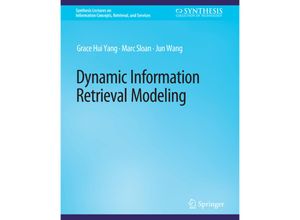Big data and human-computer information retrieval (HCIR) are changing IR. They capture the
dynamic changes in the data and dynamic interactions of users with IR systems. A dynamic system
is one which changes or adapts over time or a sequence of events. Many modern IR systems and
data exhibit these characteristics which are largely ignored by conventional techniques. What
is missing is an ability for the model to change over time and be responsive to stimulus.
Documents relevance users and tasks all exhibit dynamic behavior that is captured in data
sets typically collected over long time spans and models need to respond to these changes.
Additionally the size of modern datasets enforces limits on the amount of learning a system
can achieve. Further to this advances in IR interface personalization and ad display demand
models that can react to users in real time and in an intelligent contextual way. In this book
we provide a comprehensive and up-to-date introduction to Dynamic Information Retrieval
Modeling the statistical modeling of IR systems that can adapt to change. We define dynamics
what it means within the context of IR and highlight examples of problems where dynamics play
an important role. We cover techniques ranging from classic relevance feedback to the latest
applications of partially observable Markov decision processes (POMDPs) and a handful of useful
algorithms and tools for solving IR problems incorporating dynamics. The theoretical component
is based around the Markov Decision Process (MDP) a mathematical framework taken from the
field of Artificial Intelligence (AI) that enables us to construct models that change according
to sequential inputs. We define the framework and the algorithms commonly used to optimize over
it and generalize it to the case where the inputs aren't reliable. We explore the topic of
reinforcement learning more broadly and introduce another tool known as a Multi-Armed Bandit
which is useful for cases where exploring model parameters is beneficial. Following this we
introduce theories and algorithms which can be used to incorporate dynamics into an IR model
before presenting an array of state-of-the-art research that already does such as in the areas
of session search and online advertising. Change is at the heart of modern Information
Retrieval systems and this book will help equip the reader with the tools and knowledge needed
to understand Dynamic Information Retrieval Modeling.

